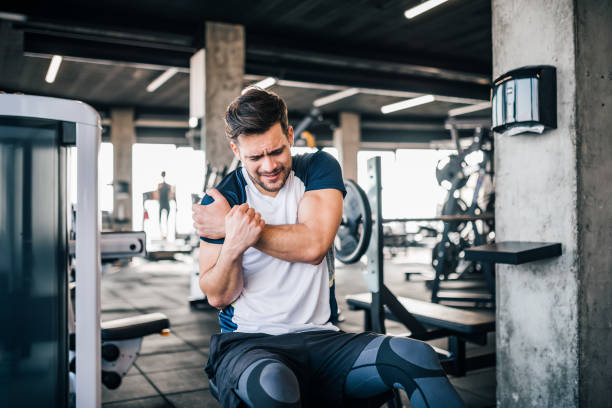
How To Prevent Common Workout Injuries: Unlocking The Secrets To A Safe And Effective Fitness Journey
How to Prevent Common Workout Injuries: Unlocking the Secrets to a Safe and Effective Fitness Journey
Related Articles
- Finding The Right Workout Shoes: A Comprehensive Guide To Comfort, Performance, And Injury Prevention
- Unlocking The Joy Of Fitness: A Comprehensive Guide To Making Your Journey Enjoyable
- Unleash Your Inner Powerhouse: How To Build Confidence Through Fitness
- How To Manage Time For Daily Workouts: Unlocking The Secret To Fitness Success
- Fitness Journey Myths Debunked: Unlocking Your True Potential
Introduction
Learn how How to Prevent Common Workout Injuries: Unlocking the Secrets to a Safe and Effective Fitness Journey can support your health goals
How to Prevent Common Workout Injuries: Unlocking the Secrets to a Safe and Effective Fitness Journey

The pursuit of fitness is a noble one, filled with the promise of improved health, increased energy, and a stronger physique. But this journey can be marred by the unwelcome intrusion of injuries. While the thrill of pushing limits is tempting, it’s crucial to prioritize safety and prevent common workout injuries. This article delves into the secrets of staying injury-free, equipping you with the knowledge and strategies to navigate your fitness journey with confidence.
Understanding the Enemy: Common Workout Injuries
Before we dive into prevention strategies, let’s identify the most common workout injuries that can hinder your progress:
1. Muscle Strains and Tears: These are the most frequent injuries, occurring when muscles are overstretched or overloaded. They often affect the hamstrings, quadriceps, and calf muscles.
2. Tendinitis: This involves inflammation of a tendon, the strong connective tissue that connects muscles to bones. Common sites include the Achilles tendon, rotator cuff, and elbow.
3. Ligament Sprains: These injuries involve stretching or tearing of ligaments, which connect bones to bones. Ankle sprains are particularly prevalent.
4. Stress Fractures: These tiny cracks in bones develop due to repetitive stress, often found in the foot, shin, or hip.
5. Lower Back Pain: A common culprit in exercise, lower back pain can arise from poor form, muscle imbalances, or overuse.
6. Knee Injuries: From meniscus tears to patellofemoral pain syndrome, the knee is susceptible to various injuries, often due to improper biomechanics or overuse.
7. Shoulder Injuries: Rotator cuff tears, impingement syndrome, and labral tears are common shoulder injuries, often stemming from overhead movements or overuse.

8. Runner’s Knee: This condition, characterized by pain around the kneecap, is often caused by overuse, weak muscles, or improper form.
Review
9. Shin Splints: Pain along the shinbone, often caused by overuse, tight calf muscles, or improper footwear, can significantly hamper your training.
10. Plantar Fasciitis: Pain in the heel and arch of the foot, often caused by overuse, tight calf muscles, or improper footwear, can make walking and running a painful experience.
The Foundation of Prevention: A Holistic Approach
Preventing workout injuries is not a one-size-fits-all approach. It requires a multi-faceted strategy, incorporating elements that address your physical, mental, and environmental factors.
1. Warming Up: Prepare Your Body for the Challenge
A proper warm-up is the cornerstone of injury prevention. It signals to your body that exercise is coming, increasing blood flow to muscles, lubricating joints, and activating muscle fibers.
- Dynamic Stretching: Focus on controlled movements that mimic your workout, like leg swings, arm circles, and torso twists.
- Light Cardio: Start with 5-10 minutes of low-intensity cardio, such as jogging, cycling, or jumping jacks.
- Targeted Muscle Activation: Include specific exercises that activate the muscle groups you’ll be working during your workout.
Step-by-Step Guide
2. Cooling Down: Recovering and Rejuvenating
Just as important as warming up, cooling down allows your body to gradually transition back to a resting state.
Tips to Maximize Your Fitness Journey
- Static Stretching: Hold stretches for 15-30 seconds, focusing on the muscles you’ve worked.
- Light Cardio: Continue with low-intensity activity to promote blood flow and flush out metabolic byproducts.
3. Listen to Your Body: The Ultimate Injury Prevention Tool
The most valuable injury prevention tool you have is your own body. Pay attention to its signals:
- Pain: Sharp, sudden pain is a red flag for potential injury. Stop the activity and rest.
- Discomfort: A dull, persistent ache can indicate overuse or muscle strain. Reduce intensity or duration of your workout.
- Fatigue: Excessive fatigue can lead to poor form and increased injury risk. Rest and allow your body to recover.
4. Proper Form: The Key to Efficient and Safe Movement
Mastering proper form is crucial for preventing injuries and maximizing workout effectiveness.
- Focus on Technique: Learn the correct form for each exercise and practice it consistently.
- Seek Expert Guidance: Consult a certified personal trainer or fitness professional to ensure your form is accurate.
- Don’t Sacrifice Form for Weight: Prioritize proper form over lifting heavy weights. Gradually increase weight as your strength improves.
5. Gradual Progression: The Path to Sustainable Strength
Avoid the temptation to jump into intense workouts without building a solid foundation.
- Start Slowly: Begin with lighter weights and fewer repetitions, gradually increasing intensity over time.
- Listen to Your Body’s Feedback: Progress at a pace that allows your body to adapt and recover.
- Don’t Overtrain: Allow adequate rest between workouts to prevent muscle fatigue and injury.
6. Strength Training: Building Resilience and Preventing Injury
Strong muscles are essential for supporting joints and preventing injuries.
- Focus on Full-Body Strength: Incorporate exercises that target all major muscle groups.
- Include Compound Movements: Exercises like squats, deadlifts, and rows engage multiple muscle groups, promoting overall strength.
- Balance Strength Training with Flexibility: Avoid muscle imbalances by training opposing muscle groups equally.
7. Flexibility and Mobility: Unlocking Optimal Movement
Flexibility and mobility are key to preventing injuries by allowing for a full range of motion and reducing muscle tightness.
- Regular Stretching: Incorporate dynamic stretches before workouts and static stretches after workouts.
- Yoga or Pilates: These practices enhance flexibility, mobility, and core strength.
- Foam Rolling: This self-massage technique helps release muscle tension and improve mobility.
8. Nutrition: Fueling Your Body for Performance and Recovery
Proper nutrition plays a critical role in injury prevention.
- Hydration: Drink plenty of water throughout the day, especially during and after workouts.
- Balanced Diet: Consume a balanced diet rich in fruits, vegetables, lean proteins, and complex carbohydrates.
- Supplement Wisely: Consider supplements like protein powder and glutamine to support muscle recovery.
9. Sleep: The Body’s Time for Repair and Regeneration
Adequate sleep is essential for muscle recovery and injury prevention.
- Aim for 7-9 Hours: Prioritize a consistent sleep schedule to optimize your body’s repair process.
- Create a Relaxing Bedtime Routine: Engage in calming activities like reading or taking a warm bath before bed.
10. Rest and Recovery: Giving Your Body the Break It Needs
Rest and recovery are often overlooked but crucial for preventing overuse injuries.
- Listen to Your Body’s Signals: Rest when your body feels fatigued or sore.
- Incorporate Active Recovery: Engage in low-impact activities like walking or swimming on rest days.
- Consider Cross-Training: Engage in different forms of exercise to reduce stress on specific muscle groups.
Advanced Tips and Tricks for Injury Prevention
1. Footwear: The Foundation of Safe Movement
- Proper Fit: Shoes should fit snugly, with enough room for your toes to wiggle.
- Support and Cushioning: Choose shoes that provide adequate support and cushioning for your activity.
- Replace Worn Shoes: Replace shoes every 300-500 miles or when they show signs of wear and tear.
2. Equipment: Ensuring Safety and Performance
- Proper Weight Selection: Start with weights that are challenging but allow you to maintain proper form.
- Secure Equipment: Ensure that weights are securely attached and that machines are properly adjusted.
- Inspect Equipment Regularly: Check for any signs of damage or wear and tear.
3. Training Environment: Optimizing Your Surroundings
- Safe Surfaces: Train on surfaces that provide adequate cushioning and traction.
- Proper Lighting: Ensure that your training area is well-lit to prevent accidents.
- Warm-Up and Cool-Down Areas: Designate areas for warming up and cooling down.
4. Mental Preparation: Mindset for Injury Prevention
- Focus on Form: Be mindful of your form throughout your workouts.
- Challenge Yourself Gradually: Increase intensity and volume gradually to allow your body to adapt.
- Stay Positive and Patient: Be patient with your progress and celebrate your successes.
5. Seek Professional Help: When to Consult a Doctor
- Severe Pain: Seek immediate medical attention if you experience sharp, intense pain.
- Swelling or Bruising: If you notice significant swelling or bruising, consult a doctor.
- Limited Range of Motion: If you experience difficulty moving a joint, seek medical evaluation.
- Numbness or Tingling: If you experience numbness or tingling in your limbs, consult a doctor.
- Recurring Injuries: If you experience the same injury repeatedly, consult a doctor to identify underlying causes.
Conclusion: Embracing a Safe and Sustainable Fitness Journey
Preventing workout injuries is not about avoiding challenges but about embracing a smart and strategic approach to fitness. By incorporating these tips and tricks into your routine, you can significantly reduce your risk of injury and enjoy a fulfilling and injury-free fitness journey. Remember, the key is to listen to your body, progress gradually, and seek professional guidance when needed.
Frequently Asked Questions
Q: What are some specific stretches for preventing common injuries?
A:
- Hamstring Strains: Hamstring stretches like the seated forward bend and the standing hamstring stretch.
- Achilles Tendinitis: Calf stretches like the standing calf stretch and the seated calf stretch.
- Lower Back Pain: Cat-cow stretch, hamstring stretch, and hip flexor stretch.
- Knee Injuries: Quadriceps stretch, hamstring stretch, and calf stretch.
- Shoulder Injuries: Shoulder rolls, arm circles, and cross-body shoulder stretch.
Q: How often should I rest between workouts?
A: Rest days are essential for muscle recovery and injury prevention. Aim for at least one rest day per week, or more if needed.
Q: What should I do if I experience pain during a workout?
A: Stop the activity immediately and rest. If the pain persists, consult a doctor.
Q: How can I prevent overuse injuries?
A: Gradually increase intensity and volume, listen to your body’s signals, and incorporate rest days into your routine.
Q: What are some signs of overtraining?
A: Overtraining can manifest as fatigue, muscle soreness, decreased performance, and increased risk of injury.
Q: What are some tips for staying motivated with injury prevention?
A: Set realistic goals, find a workout buddy, and celebrate your successes. Remember, consistency is key to a successful and injury-free fitness journey.
Q: What are some resources for learning more about injury prevention?
A: Consult a certified personal trainer, physical therapist, or sports medicine professional. You can also find valuable information online from reputable sources like the American College of Sports Medicine (ACSM) and the National Athletic Trainers’ Association (NATA).
Source URL:
Closure
Thank you for joining us; keep visiting for updates on How to Prevent Common Workout Injuries: Unlocking the Secrets to a Safe and Effective Fitness Journey and related topics.
Let us know your thoughts on How to Prevent Common Workout Injuries: Unlocking the Secrets to a Safe and Effective Fitness Journey in the comments below.
Keep up with our latest fitness and wellness content!



